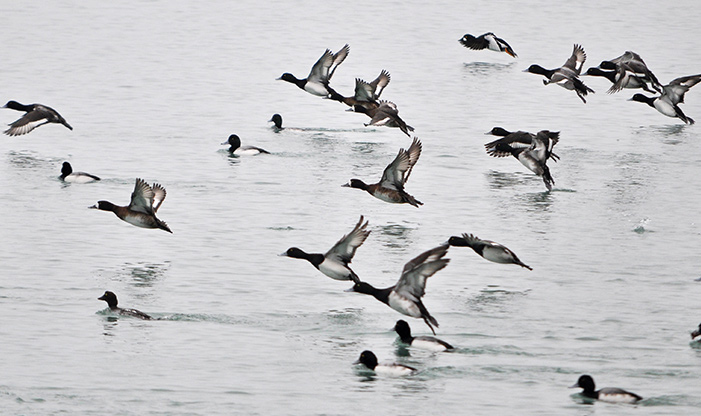When most people think about fall migration they envision birds flying south out of Wisconsin’s winter weather toward warmer and more food-filled climates. However, lots of winter waterfowl fly south to Wisconsin. Many diving ducks that nest in Canada, Alaska, and further north spend their winters in the frigid but open water of Lake Michigan and the other Great Lakes.
As water in the north freezes and cuts off their food supply, ducks fly south, but often only far enough to find open water. The Great Lakes, which rarely freeze, provide this open water, as well as plenty of food. Here they dine on aquatic invertebrates, clams, small fish, and plant material.
Schlitz Audubon is part of the Ozaukee Bight Lakeshore Migration Corridor, which stretches from Port Washington to the Center. This bight, or inlet, has been designated an Important Bird Area in part because it is a beneficial habitat for ducks in winter, and therefore is one of the places to witness a huge concentration of migrant diving ducks. These waterfowl can dive underwater from 25 seconds to over a minute.
From November through April, Greater Scaup, Common Goldeneye, Bufflehead, Red-breasted Mergansers, and a few other species are regularly seen in large rafts from our beach.
Greater Scaup
The medium-sized male Greater Scaup shows a dark round head, chest and rear that contrasts with its white sides and gray back. The greenish iridescence on the scaup’s head is rarely visible. The white facial patch on the otherwise brownish colored female Greater Scaup makes her easy to identify.
There is another species of scaup found in winter called the Lesser Scaup. They can be difficult to differentiate, but a key field mark is an egg-shaped head, and slightly smaller in overall size.
Common Goldeneye
Another medium-sized duck, the Common Goldeneye, has a triangular head and a sloping bill. The male’s nearly all white body displays a dark back and the head is an iridescent green (although it often looks black) with a white spot near the eponymous “golden” eye. The females are grayish-brown with a darker, warm brown head, sporting a black bill with a yellow tip. The female’s eye is usually a paler shade of yellow compared to the male’s bright golden eye.
Bufflehead
At only 13 inches, Bufflehead are one of our smaller winter ducks. The male Bufflehead’s has a large, dark head with a white patch toward the back. When the sun hits Bufflehead males at the perfect angle, their head appears iridescent green and purple, but can be rare to see. Its back is also dark, with white chest and sides. Female Bufflehead are an all-over brown color with a white patch behind her eye. Bufflehead are fun to watch take flight on Lake Michigan. They run a short distance on the surface of the lake before lifting off!
Red-breasted Merganser
In contrast to the petite Bufflehead, the Red-breasted Merganser measures 23 inches in length. As their name suggests, the male sports a reddish breast on a gray body. The merganser has a white ring around its neck, a green head with a shaggy crest at the rear, and an orange bill in front. The merganser’s long and thin bill has a serrated edge—an adaptation for catching fish. The female is mostly gray with a reddish head bearing the same shaggy crest and serrated bill as the male.
Although the food supply is abundant, the temperature of the water hovers just above freezing. How do the ducks stay warm? Ducks, like most birds, are equipped with an oil filled preen gland at the base of their tail. The birds rub their beak into the oil, spreading it all over their feathers, effectively making them waterproof. Secondly, a duck’s feet have a special counter-current heat exchange system between the arteries and veins in their legs. Warm arterial blood flowing to the feet passes close to the cold venous blood returning from the feet. This keeps their feet just warm enough to avoid frostbite.
Besides the four common species you read about here, scoters, loons, grebes, and other merganser species are also possible to see in smaller numbers from our shoreline. Since all of these species can stay underwater for quite some time, be prepared to see these winter waterfowl dive in one place and then pop up a fair distance from where they originally went under. You can even turn it into a game! So grab your binoculars or scope, and visit the Center’s lakeshore this winter to see how many species you can find.
To learn about identifying waterfowl, join us for Identifying Winter Ducks on January 12!


